课后作业——2022.10.15
1.动手动脑:
请阅读并运行AboutException.java示例,然后通过后面的几页PPT了解Java中实现异常处理的基础知识。
import javax.swing.*; class AboutException { public static void main(String[] a) { int i=1, j=0, k; k=i/j; try { k = i/j; //Causes division-by-zero exception throw new Exception("Hello.Exception!"); } catch ( ArithmeticException e) { System.out.println("被0除. "+ e.getMessage()); } catch (Exception e) { if (e instanceof ArithmeticException) System.out.println("被0除"); else { System.out.println(e.getMessage()); } } finally { JOptionPane.showConfirmDialog(null,"OK "+k); } } }
结果:

结论:
把可能会发生错误的代码放进try语句块中。
当程序检测到出现了一个错误时会抛出一个异常对象。异常处理代码会捕获并处理这个错误。
catch语句块中的代码用于处理错误。
当异常发生时,程序控制流程由try语句块跳转到catch语句块。
不管是否有异常发生,finally语句块中的语句始终保证被执行。
如果没有提供合适的异常处理代码,JVM将会结束掉整个应用程序。
Throwable类有两个直接子类:
Exception:出现的问题是可以被捕获的;
Error:系统错误,通常由JVM处理。
2.请尝试解释以下奇怪的现象
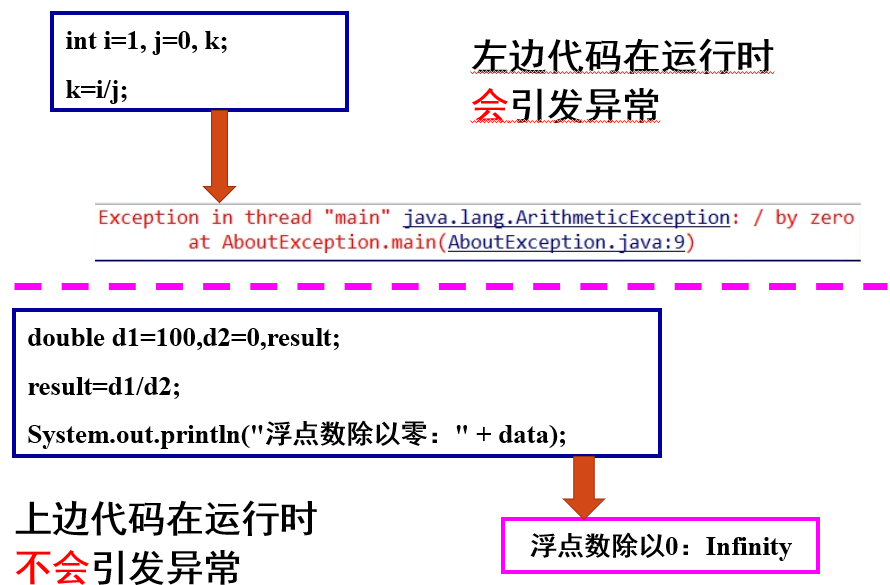
结论:
(1)的代码运行时会引发异常,而(2)的代码不会引发异常!为什么?
对于(1)而言,java生成的是idiv字节码指令,而(2)java生成的是ddiv字节码指令,
JVM在具体实现这两个指令是,采用了不同的处理策略,导致两段代码运行时得到不同的结果
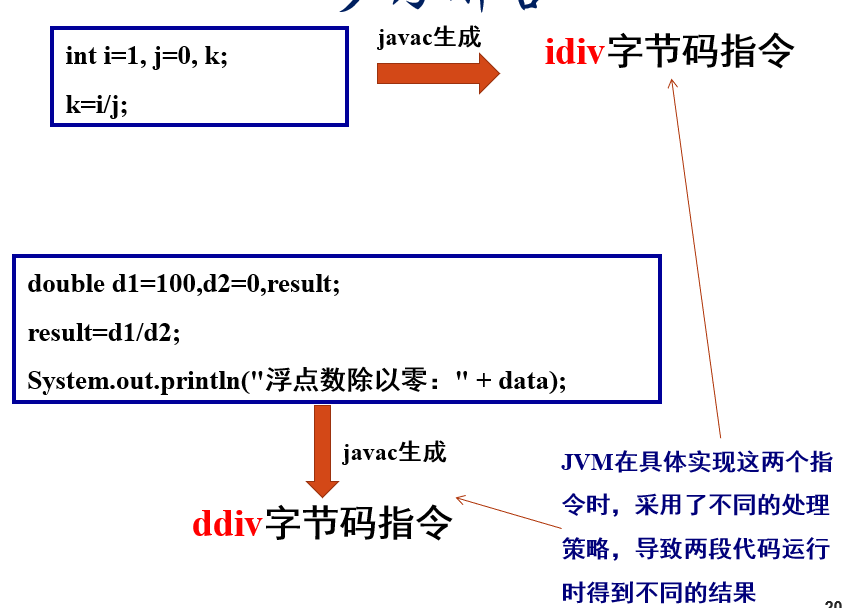
3.动手动脑:多层的异常捕获
阅读以下代码(CatchWho.java),写出程序运行结果:
代码:
public class CatchWho { public static void main(String[] args) { try { try { throw new ArrayIndexOutOfBoundsException(); } catch(ArrayIndexOutOfBoundsException e) { System.out.println( "ArrayIndexOutOfBoundsException" + "/内层try-catch"); } throw new ArithmeticException(); } catch(ArithmeticException e) { System.out.println("发生ArithmeticException"); } catch(ArrayIndexOutOfBoundsException e) { System.out.println( "ArrayIndexOutOfBoundsException" + "/外层try-catch"); } } }
结果:

写出CatchWho2.java程序运行的结果:
代码:
public class CatchWho2 { public static void main(String[] args) { try { try { throw new ArrayIndexOutOfBoundsException(); } catch(ArithmeticException e) { System.out.println( "ArrayIndexOutOfBoundsException" + "/内层try-catch"); } throw new ArithmeticException(); } catch(ArithmeticException e) { System.out.println("发生ArithmeticException"); } catch(ArrayIndexOutOfBoundsException e) { System.out.println( "ArrayIndexOutOfBoundsException" + "/外层try-catch"); } } }
结果:

throw一个异常后,必须catch成功,才能throw下一个异常,系统不能累积处理异常
4.动手动脑:
当有多个嵌套的try…catch…finally时,要特别注意finally的执行时机。
请先阅读 EmbedFinally.java示例,再运行它,观察其输出并进行总结。
代码:
public class EmbededFinally { public static void main(String args[]) { int result; try { System.out.println("in Level 1"); try { System.out.println("in Level 2"); // result=100/0; //Level 2 try { System.out.println("in Level 3"); result=100/0; //Level 3 } catch (Exception e) { System.out.println("Level 3:" + e.getClass().toString()); } finally { System.out.println("In Level 3 finally"); } // result=100/0; //Level 2 } catch (Exception e) { System.out.println("Level 2:" + e.getClass().toString()); } finally { System.out.println("In Level 2 finally"); } // result = 100 / 0; //level 1 } catch (Exception e) { System.out.println("Level 1:" + e.getClass().toString()); } finally { System.out.println("In Level 1 finally"); } } }
结果:
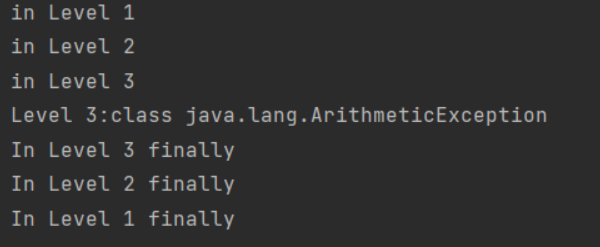
当有多层嵌套的finally时,异常在不同的层次抛出 ,在不同的位置抛出,可能会导致不同的finally语句块执行顺序。
5.动手动脑:
finally语句块一定会执行吗?
请通过 SystemExitAndFinally.java示例程序回答上述问题
代码:
public class SystemExitAndFinally { public static void main(String[] args) { try{ System.out.println("in main"); throw new Exception("Exception is thrown in main"); //System.exit(0); } catch(Exception e) { System.out.println(e.getMessage()); System.exit(0); } finally { System.out.println("in finally"); } } }
结果:

不一定,因为当代码 System.exit(0);意思是,终止JAVA虚拟机,导致不能执行finally的内容!
6.请通过 PrintExpressionStack.java示例掌握上述内容。依据对本讲多个示例程序的分析,请自行归纳总结出Java多层嵌套异常处理的基本流程。
代码:
// UsingExceptions.java // Demonstrating the getMessage and printStackTrace // methods inherited into all exception classes. public class PrintExceptionStack { public static void main( String args[] ) { try { method1(); } catch ( Exception e ) { System.err.println( e.getMessage() + "\n" ); e.printStackTrace(); } } public static void method1() throws Exception { method2(); } public static void method2() throws Exception { method3(); } public static void method3() throws Exception { throw new Exception( "Exception thrown in method3" ); } }
结果:

7.
请看以下代码,它们完全符合Java语法规范,但事实是它们不能通过编译:
public class TestThrows {
public static void main(String[] args) {
FileInputStream fis = new
FileInputStream("a.txt");
}
}
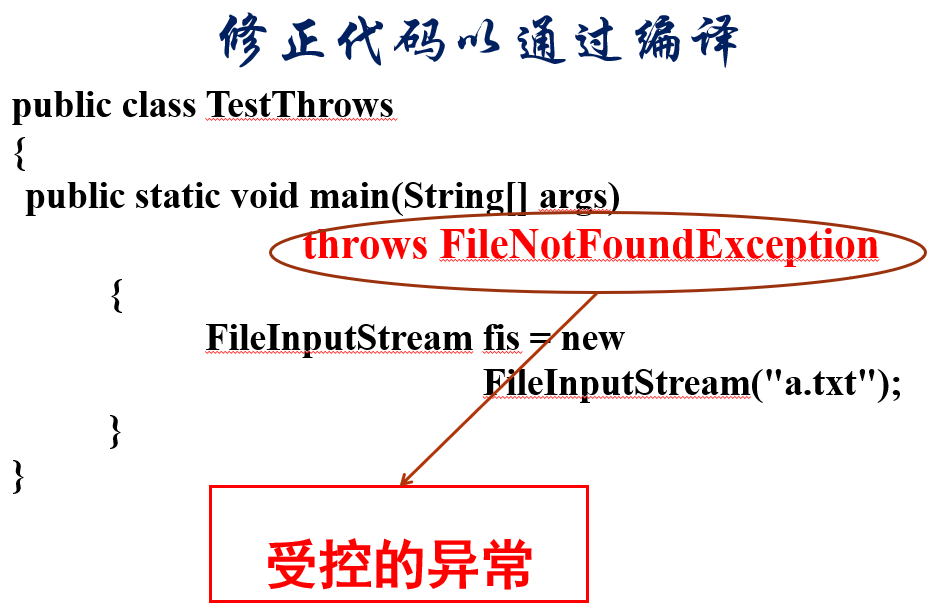
结果:
throws语句表明某方法中可能出现某种(或多种)异常,但它自己不能处理这些异常,而需要由调用者来处理。
当一个方法包含throws子句时,需要在调用此方法的代码中使用try/catch/finally进行捕获,或者是重新对其进行声明,否则编译时报错。
throws语句中声明的异常称为受控(checked)的异常,通常直接派生自Exception类。
RuntimeException(其基类为Exception) 和Error(基类为Throwable)称为非受控的异常。这种异常不用在throws语句中声明。
CheckedExceptionDemo.java示例展示了上述两种异常的特性。
8.抛出多个受控异常的方法
一个方法可以声明抛出多个异常
int g(float h) throws OneException,TwoException
{ …… }
ThrowMultiExceptionsDemo.java示例展示了相关特性。
注意一个Java异常处理中的一个比较独特的地方:

import java.io.*; public class ThrowMultiExceptionsDemo { public static void main(String[] args) { try { throwsTest(); } catch(IOException e) { System.out.println("捕捉异常"); } } private static void throwsTest() throws ArithmeticException,IOException { System.out.println("这只是一个测试"); // 程序处理过程假设发生异常 throw new IOException(); //throw new ArithmeticException(); } }
结果:
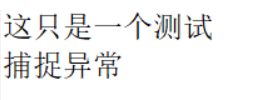
9.
一个子类的throws子句抛出的异常,不能是其基类同名方法抛出的异常对象的父类。
OverrideThrows.java示例展示了Java的这个语法特性。
代码:
import java.io.*; public class OverrideThrows { public void test()throws IOException { FileInputStream fis = new FileInputStream("a.txt"); } } class Sub extends OverrideThrows { //如果test方法声明抛出了比父类方法更大的异常,比如Exception //则代码将无法编译…… public void test() throws FileNotFoundException { //... } }
10.在实际开发中,经常需要将特定的“过于专业”的异常转换为一个“业务”异常,然后在调用者处进行捕获与处理。
ExceptionLinkInRealWorld.java示例展示了典型的异常处理代码模板
代码:
/** * 自定义的异常类 * @author JinXuLiang * */ class MyException extends Exception { public MyException(String Message) { super(Message); } public MyException(String message, Throwable cause) { super(message, cause); } public MyException( Throwable cause) { super(cause); } } public class ExceptionLinkInRealWorld { public static void main( String args[] ) { try { throwExceptionMethod(); //有可能抛出异常的方法调用 } catch ( MyException e ) { System.err.println( e.getMessage() ); System.err.println(e.getCause().getMessage()); } catch ( Exception e ) { System.err.println( "Exception handled in main" ); } doesNotThrowException(); //不抛出异常的方法调用 } public static void throwExceptionMethod() throws MyException { try { System.out.println( "Method throwException" ); throw new Exception("系统运行时引发的特定的异常"); // 产生了一个特定的异常 } catch( Exception e ) { System.err.println( "Exception handled in method throwException" ); //转换为一个自定义异常,再抛出 throw new MyException("在方法执行时出现异常",e); } finally { System.err.println( "Finally executed in throwException" ); } // any code here would not be reached } public static void doesNotThrowException() { try { System.out.println( "Method doesNotThrowException" ); } catch( Exception e ) { System.err.println( e.toString() ); } finally { System.err.println( "Finally executed in doesNotThrowException" ); } System.out.println( "End of method doesNotThrowException" ); } }
结果:
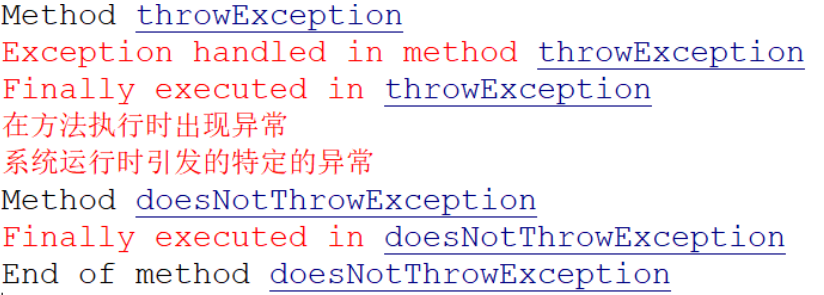
在实际开发中,可以参照ExceptionLinkInRealWorld.java
示例的做法,定义一些与业务逻辑相关的自定义异常类,供上层代码进行捕获,从而能更精确地反映系统真实运行情况并及时进行处理。

